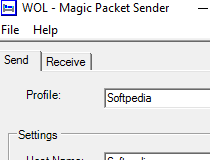
- Iphone magic packet sender pro#
- Iphone magic packet sender software#
- Iphone magic packet sender windows#
To truly understand the power of packet sniffers, it’s important to establish a sound knowledge base of internet routing.
Iphone magic packet sender software#
This comprehensive software offers in-depth packet sniffing capabilities as well as a host of other cutting-edge resources at a reasonable price point. My personal favorite is the SolarWinds Network Performance Monitor. The best packet sniffers then analyze this data, enabling you to both pinpoint the source of an issue and prevent it from happening in the future.
Iphone magic packet sender windows#
There are a variety of tools on the market, most of which rely on application program interfaces (APIs) known as pcap (for Unix-like systems) or libcap (for Windows systems) to capture network traffic.


These tools aid in the identification, classification, and troubleshooting of network traffic by application type, source, and destination.
SolarWinds Network Performance Monitor (My personal favorite tool)Ī packet sniffer is either a software or hardware tool to intercept, log, and analyze network traffic and data. With the right packet sniffer, you’ll be well-equipped to capture and analyze network traffic, helping you identify the cause of network performance problems and prevent them from recurring.Ī Word of Warning - How Hackers Use Packet Sniffers This is where packet sniffers, also known as network sniffers or network analyzers, come into play. Getting to the root cause of performance problems is a top priority for nearly every sysadmin. Or it could be the same problem, I don't know.It’s no question that bottlenecks, downtime, and other common network performance issues can vastly affect the end-user experience and put productivity on hold, ultimately cutting into your company’s bottom line. However the culprit for that could also be that the WiFi chip has some different problem. (It also did not wake up when I tested connecting the computer through WiFi. I could not find any port routing section in the router's options, however isn't the router already working perfectly as "Magic Packet Received" does work, just the computer doesn't wake up? However the main question is, what can I try to get the WOL working? How is that possible? Where is the magic packet "queued"? Or are they some sort of noise, false alarms? But after 1, 2 or even 10 minutes later, surprisingly popups appear one at a time. So when the computer is sleeping, I do that, nothing happens. At least the listener program gives three consequtive popups when pressing "Wake Up". What exactly happens there? iPhone has this program WOL which I use. The strange thing is, if I trigger the magic packet (from my phone for example, which does wake up my other computers – which are not behind the same router) the popup "Magic Packet Received" will appear after a long while after the computer has already been switched on normally. Tried Only allow a magic packet to wake the computer and also that disabled, no difference. The problem is, the computer does not wake up no matter what. And Allow this devicee to wake the computer. There I have Allow the computer to turn off this device to save power (tried also disabling that). In Device Manager, I went through all items and the only relevant I could find is Realtek USB GbE Family Controller. My Ethernet adapter is on a USB dock called Startech USB C Multiport Adapter DKT30CHVAUSP. If I launch a little program called "WOL - Magic Packet Sender", put it in Receive mode, send magic packet to MacBook, the program will immediately say "Magic Packet Received". Iphone magic packet sender pro#
MacBook Pro 16" 2019 is connected to that router via ethernet. Weird behavior on magic packet comptur wakeup Also I don't want to disable WOL functionality altogether, because it's very convenient to remotely wake and access home PC. I also checked my router log files - only magic packets being sent are from my phone when I genuienly needed to wake up PC.

But now computer keeps waking up at random moments around 30min to 1hour after being put to sleep and "powercfg -lastwake" shows that it's the ethernet module that wakes computer up, although it's set to wake from only Magic Packet. Recently I made fresh installation of Windows 10, installed all manufacturer's drivers, configured network adapter as before (wake on LAN only on Magic Packet), also disabled all other wake timers - everything is set as before. For few years I was running Windows 8, and had configured computer to wake only on Magic Packet being received on port 9 - everything worked flawless. I'm using Asrock Z87 Pro motherboard with onboard Intel I217-V network adapter. Computer wakes on LAN, even if Magic Packet is enabled







 0 kommentar(er)
0 kommentar(er)
